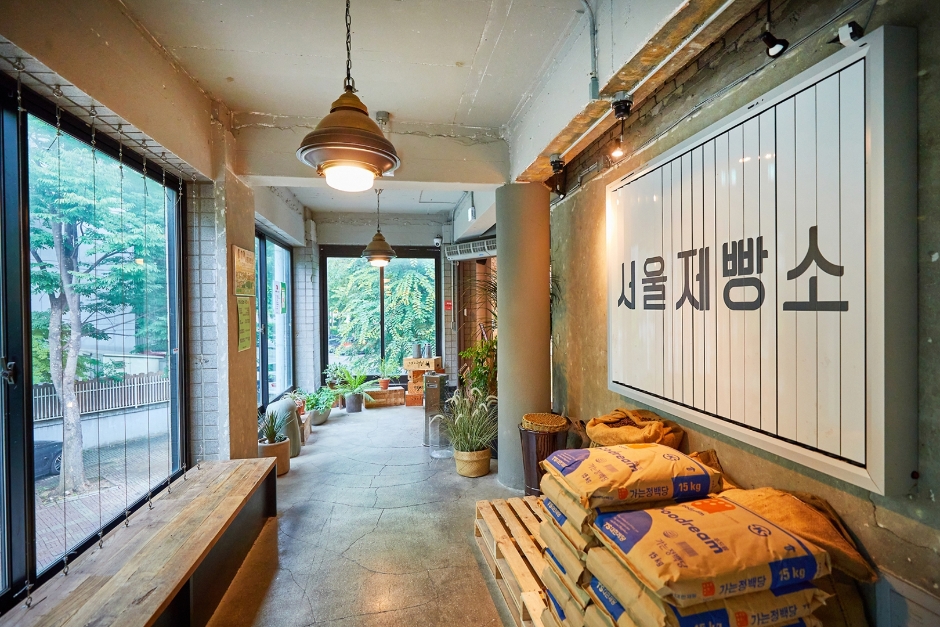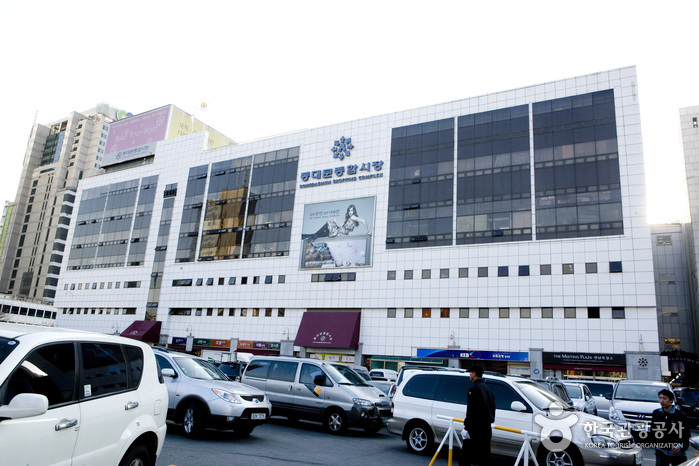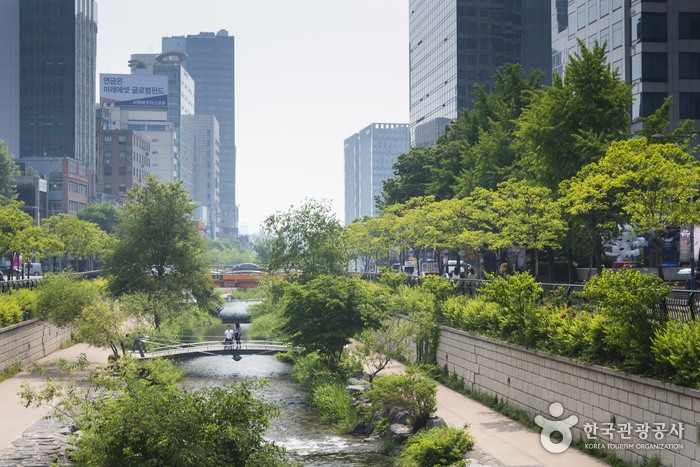Chungmuro Busan Bokjip (충무로 부산복집)
7.1Km 2024-02-28
9-1 Jungdae-ro 27-gil, Songpa-gu, Seoul
+82-2-404-3227
Chungmuro Busan Bokjip is a puffer fish cuisine restaurant situated near Ogeum Park and Olympic Park. The signature menu is the jajubong maeuntang (spicy tiger puffer fish stew), offering a flavorful and refreshing broth made with fresh puffer fish, green onions, radishes, and kelp. Another popular dish is the spicy and sweet bulgogi with fresh puffer fish. Additionally, the bogeo shabu-shabu (puffer fish shabu-shabu) allows diners to enjoy fresh vegetables and puffer fish cooked at the table. Nearby attractions include Seokchonhosu Lake and Lotte World.
GS25 - Junggu Toegye Branch [Tax Refund Shop] (GS25중구퇴계점)
7.1Km 2024-06-27
180, Toegye-ro, Jung-gu, Seoul
-
Seoul Bakery (서울제빵소 올림픽본점)
7.2Km 2024-03-20
1178 Yangjae-daero, Songpa-gu, Seoul
This bakery cafe is located on the second floor of a commercial wing attached to the Olympic Village Apartments, located across from Olympic Park’s Rose Plaza. The spacious cafe features naturally fermented bread made with organic flour and seats looking out the window. The interior is modern and open, with plenty of seats for long stays. Naturally fermented bread here includes Hongguk rice bread, salt bread, and cream cheese and fig bread. Bread is baked from 08:00 to midday. Visitors can find a timetable for the different kinds of bread served in this cafe in order to make plans in advance to get freshly-baked bread.
Seoul Yangnyeongsi Market (서울 약령시장)
7.2Km 2021-06-09
10, Yangnyeongjungang-ro, Dongdaemun-gu, Seoul
+82-2-969-4793
"Yangnyeongsi," which literally means medicine city district, refers to a central Oriental medicine district formed near major cities where medicinal herbs are collected and produced. Yangneongsi were first established by royal order during the Joseon dynasty for the purpose of effective production, distribution and management of medicinal products and herbs.
Seoul Yangnyeongsi Market history is relatively short, having formed naturally in the mid-1960s by medicinal herb merchants who gathered here seeking to sell their products with the city bus terminal and Cheongnyangni Station as their central base. Originally, these merchants came to Seoul through the old Seongdong Station and Chyeongnyangni Station after the Korean War, seeking to sell medicinal herbs and vegetation products that were cultivated and collected in the Gyeonggi-do and Gwangwon-do regions. This small market that was once open on an empty plot of land was later authorized as an official market establishment. Road and railroad developments between Gangwon-do and Seoul were followed and by the 1970s, the market grew into what is now seen today. The name Seoul Yangnyeongsi Market was given by the Seoul mayor in 1995.
Dongdaemun Shopping Complex·Dongdaemun Shopping Town (동대문 종합시장·동대문 쇼핑타운)
7.2Km 2025-06-30
266 Jong-ro, Jongno-gu, Seoul
+82-2-2262-0114
Dongdaemun Shopping Complex is one of Korea’s most well-known markets. It was founded in December 1970 as the largest of its kind in Asia and has maintained that status for the last 40 years. Browsing the plethora of shops, you can find fabric and clothing following all the latest global fashion trends. Dongdaemun Shopping Complex continues to build up its reputation as a hub of international design.
Dongdaemun Shopping Complex (Hanbok Shops) (동대문종합시장 한복상가)
7.2Km 2021-09-15
266, Jong-ro, Jongno-gu, Seoul
+82-2-2262-0114
As one of the largest markets in Asia, Dongdaemun Shopping Complex boasts huge hanbok shops. Most of the major hanbok and fabric distributors are located here. It offers a wide array of hanbok from traditional hanbok to modernized hanbok in addition to accessories and clothing materials. Dongdaemun Shopping Complex is a popular spot among international tourists who want to experience traditional Korean culture and purchase various souvenirs.
Enter 6 - Cheonho Station Branch [Tax Refund Shop] (㈜엔터식스패션쇼핑몰 천호역점)
7.2Km 2024-04-19
B1, Cheonho Station of Subway Line 5, 8, 997, Cheonho-daero, Gangdong-gu, Seoul
-
Cheonggyecheon Stream (청계천)
7.2Km 2024-05-16
Changsin-dong, Jongno-gu, Seoul
+82-2-2290-7111
Cheonggye Plaza was built on Sejong-ro Street, where Cheonggyecheon Stream begins. It was built between Dong-A Ilbo, the starting point of the Cheonggyecheon Stream restoration, and Sindap Railroad Bridge, with a length of 160 meters, a x_width of 50 meters, and a total area of 6,962 meters squared. The plaza is decorated with fountains, waterfalls, and walking paths. It was created as a place for meetings, harmony, peace, and unification, to celebrate the significance of the restoration of Cheonggyecheon Stream. A miniaturized version of Cheonggyecheon Stream is displayed here, providing an overview of the restored stream. There are also interpretive panels about the 22 bridges that cross Cheonggyecheon stream. Fountains of various shapes create beautiful scenery. Cheonggyecheon Stream is accessible from the square through stairs on the left and Cheonggye Trail on the right. There is also an 18-meter tunnel on the Cheonggye Trail, providing a unique experience for citizens entering Cheonggyecheon Stream from the plaza. After constructing Cheonggyecheon Plaza, the Seoul Metropolitan Government made it a car-free street on public holidays so that the plaza, waterside area, and streets could be used as cultural spaces for citizens to relax. A spectacular sight is created by three-color lights illuminating the fountains and a two-tiered waterfall coming down from a x_height of four meters. Palseokdam, made of eight stones from eight provinces in Korea, was laid along the waterfall's sides.
Hanok Stay Unnie house [Korea Quality] 한옥스테이 언니집 [한국관광 품질인증]
7.2Km 2024-08-14
13-3, Wangsan-ro 5-gil, Dongdaemun-gu, Seoul
+82-504-0904-2568
Unnie house ("Sister House") on Wangsan-ro, Dongdaemun-gu, Seoul, is a private hanok stay in the heart of the city. The house is inside an alleyway, where it’s quiet and tranquil. The accommodation consists of a living room, kitchen with exposed beams, lounge with a beam projector for watching movies, bathroom, bedroom, separate tea ceremony room, and yard. The absence of clutter and attention to detail in this space will heal and relax.
JDX - Munjeong Branch [Tax Refund Shop] (JDX 문정)
7.2Km 2024-04-18
96, Dongnam-ro, Songpa-gu, Seoul
-





![Hanok Stay Unnie house [Korea Quality] 한옥스테이 언니집 [한국관광 품질인증]](http://tong.visitkorea.or.kr/cms/resource/00/2948900_image2_1.jpg)
 English
English
 한국어
한국어 日本語
日本語 中文(简体)
中文(简体) Deutsch
Deutsch Français
Français Español
Español Русский
Русский